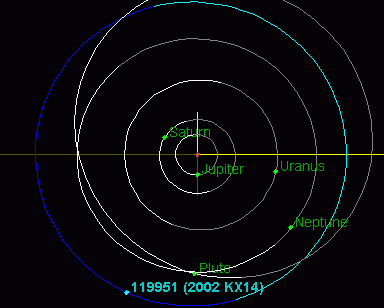astro.wikisort.org - Astéroïde
(119951) 2002 KX14 est un objet transneptunien qui serait un cubewano, ou peut-être une plutino.
(119951) 2002 KX14
| Demi-grand axe (a) |
5,79 × 109 km (38,701 ua) |
|---|---|
| Périhélie (q) |
5,52 × 109 km (36,894 ua) |
| Aphélie (Q) |
6,06 × 109 km (40,508 ua) |
| Excentricité (e) | 0,047 |
| Période de révolution (Prév) |
88 152 ± 21 j (241,35 a) |
| Inclinaison (i) | 0,4° |
| Longitude du nœud ascendant (Ω) | 286,7° |
| Argument du périhélie (ω) | 75,8° |
| Anomalie moyenne (M0) | 251,1° |
| Catégorie | Cubewano |
| Dimensions |
< 562 +220 −182 km [1] |
|---|---|
| Magnitude absolue (H) | 4,7 |
| Plus ancienne observation de pré-découverte | |
|---|---|
| Date | |
| Découvert par |
C. Trujillo, M. E. Brown |
| Désignation | 2002 KX14 |
Caractéristiques
2002 KX14 mesure environ 562 km de diamètre.
Orbite
L'orbite[2] de 2002 KX14 possède un demi-grand axe de 38,701 ua et une période orbitale d'environ 241 ans. Son périhélie l'amène à 36,894 ua du Soleil et son aphélie l'en éloigne de 40,508 ua.

Il sera en opposition en avec une magnitude de 20,4[3],[4], ce qui le rend 360 fois plus faible que Pluton[5].

Découverte
2002 KX14 a été découvert le [2].
Références
- Stansberry, John; et al. (2007). "Physical Properties of Kuiper Belt and Centaur Objects: Constraints from Spitzer Space Telescope". arXiv:astro-ph/0702538 [astro-ph].
- « List Of Transneptunian Objects », The Minor Planet Center (MPC) (consulté le )
- "(119951) 2002 KX14". (epoch) Minor Planet Center. 2010-07-23. Retrieved 2010-10-24.
- HORIZONS Web-Interface". JPL Solar System Dynamics. Retrieved 2008-07-20
- (Racine cinquième de 100)^(20,4-14) = 363
Annexes
Liens internes
- Liste des planètes mineures (119001-120000)
- Objet transneptunien
Liens externes
- (en) Caractéristiques et simulation d'orbite de 119951 sur la page Small-Body Database du JPL. [java]
- (en) Minor Planet Center database
- Portail de l’astronomie
- Portail des planètes mineures et comètes
На других языках
[de] (119951) 2002 KX14
Vorlage:Infobox Asteroid/Wartung/Umlaufdauer[en] (119951) 2002 KX14
(119951) 2002 KX14, also written as 2002 KX14, is a medium-sized trans-Neptunian object (TNO) residing within the Kuiper belt. It was discovered on 17 May 2002 by Michael E. Brown and Chad Trujillo.[1]- [fr] (119951) 2002 KX14
[ru] (119951) 2002 KX14
(119951) 2002 KX14 — транснептуновый объект, расположенный в поясе Койпера. Он был обнаружен 17 мая 2002 года Мишелем Е. Брауном и Чадом Трухильо.Текст в блоке "Читать" взят с сайта "Википедия" и доступен по лицензии Creative Commons Attribution-ShareAlike; в отдельных случаях могут действовать дополнительные условия.
Другой контент может иметь иную лицензию. Перед использованием материалов сайта WikiSort.org внимательно изучите правила лицензирования конкретных элементов наполнения сайта.
Другой контент может иметь иную лицензию. Перед использованием материалов сайта WikiSort.org внимательно изучите правила лицензирования конкретных элементов наполнения сайта.
2019-2025
WikiSort.org - проект по пересортировке и дополнению контента Википедии
WikiSort.org - проект по пересортировке и дополнению контента Википедии